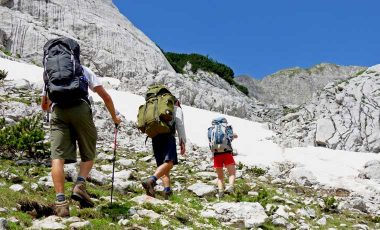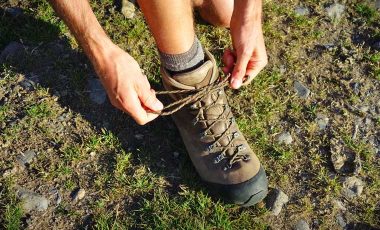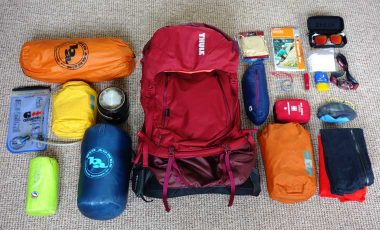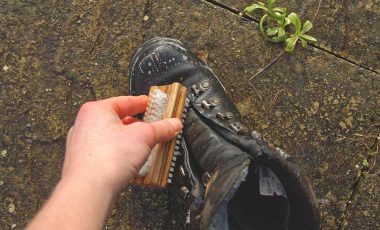If you’re planning a hiking trip, then getting into shape is essential. The right training will help prevent injury during your hike, as well as ensuring your body can cope with days on end of challenging terrain whilst carrying a heavy pack. The result is that you’ll enjoy the hike much, much more! So to make sure you get trail fit in time for your next big trip, our guide will talk you through how to train for hiking, with advice, videos, tips and a training program.
Of course getting out on the trail as much as possible is the best way to train for hiking. But for most of us, there’s just not enough hours in the day to do as much as we need. Get some strength exercises for hiking into your routine, however, and you’ll be well on your way to good trail fitness.
You don’t need to spend hours at the gym to train for hiking either. In fact all of the exercises we recommend can be done at home, in the park or at the beach using minimal equipment. But if you prefer keeping your workouts in the gym, there’s always the option of varying and progressing the strength exercises using the equipment available.
The benefits of training for hiking
It’s a very common mistake to think that if you are reasonably fit and strong then you don’t really need to train for a multi-day hiking trip. And in certain scenarios, that may be the case. If the days are short, on easy terrain, in moderate weather and you aren’t carrying too much gear, then yes, you might just get away with it (depending on your age and fitness levels).
However, for those wanting to get some serious miles in on steep, challenging terrain, carrying all your food and gear and in variable weather conditions, training is essential.
Here’s why you need to train for hiking:
- To strengthen and stabilise your joints (knees and ankles especially): These joints are put through a lot of stress when hiking. Uneven ground from below and heavy pack from above makes having stability totally essential to prevent falls, twists and sprains.
- To improve your cardiovascular endurance: Your lungs need to be able to deal with tackling steep and prolonged ascents. Training your cardiovascular system will enable you to keep your pace up with minimal rests, allowing your to cover more distance in comfort.
- To strengthen your muscles: Strong muscles make you more stable on your feet, allow you to tackle challenging terrain (big steps ups and downs) with ease, and prevent you from fatiguing too quickly. Being strong is especially important if you are carrying a heavy pack, and your training should reflect this.
- You’ll have more fun: Hiking without training can mean that every step fast becomes difficult, uncomfortable or even painful, taking all the enjoyment out of it. Get into shape, however, and you’ll minimise the risk of injury, won’t get too fatigued, will power up and down the tough sections, and have a great time! ‘No pain, no gain’ thinking might work for some people, but if it leads to injury and misery when out hiking then it kind of defeats the point!
How to train for hiking
Most hikers will tell you that the best way to train for hiking is to hike. And although hiking is an essential part of any training plan, most of us simply can’t fit in three 6 hour hikes each week!
With advice from Ramsey Bergeron, personal trainer and adventure travel guide, I’ve put together an easy to follow training plan. You’ll be able to fit it into to your everyday life without having to commit to an unreasonable amount of hours on the trail, plus, you can do the whole lot without having to set foot inside a gym!
Hiking training schedule
If possible, try to start your training 8-12 weeks before your hiking trip. But if you’ve not got that long then just do what you can.
| Day 1: | Circuit — see below for details |
| Day 2: | Run/cycle/swim |
| Day 3: | Short hike — see below for details |
| Day 4: | Circuit — see below for details |
| Day 5: | Stretch and stroll — walk whenever you can and stretch for 15-30 minutes |
| Day 6: | Long hike — see below for details |
| Day 7: | Stretch and stroll — walk whenever you can and stretch for 15-30 minutes |
Short hike
Length: 1-2 hours
Pace: Fast — you should be out of breath the whole time
Terrain: Start on flat-ish routes and build up to steep terrain
If possible, try to fit in a mid-week hike before or after work. This should be done with weight in a backpack: start with a daypack and add more weight each week. Then upgrade to a larger backpack and build up the weight again. In the last two weeks of training aim to do this hike with a fully loaded backpack.
Long hike
Length: 2-6 hours — start short and build up to the duration of the longest day on your hiking trip
Pace: Normal walking pace
Terrain: Varied with steep/challenging sections
Aim to get out on a big hike each weekend during your training. As with your short hike, start with a daypack, increasing the weight each week for a month or so. Switch it for a large backpack and increase the weight until it is fully loaded for your last weekend hike.
To ensure that you are improving your hiking fitness, you should aim to increase the distance and/or difficulty of the route each week.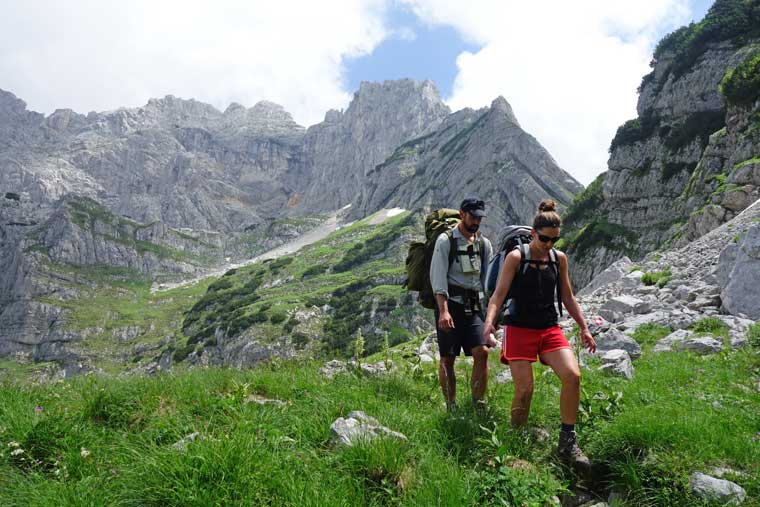
Circuit training for hiking
I’m a big fan of circuits. They’re short, sharp and highly effective — ideal for fitting into a busy life.
As mentioned, strength training for hiking is also super important to prevent injuring and improve endurance. This circuit includes some excellent strength exercises to prepare for hiking. And when done as a circuit, it will also improve cardiovascular endurance.
Each exercise is described in detail with a video in the Strength exercises for hiking section.
The circuit can be done at home, in the garden, at the park, or at the beach, and with very little equipment.
Hike training circuit
Mountain climbers x 20 done in between each of the below exercises
- Step ups x 20 on each leg
- Banded side steps x 20 in each directions
- Hip thrusters x 10-12
- Bulgarian split squat x 10-12 on each leg
- Band pull aparts x 15-20
- Lateral step ups x 15-20 on each leg
- Walking lunges x 16-20
Try to rest as little as possible between each exercise.
Rest for 2-3 minutes once you have completed each exercise in sequence.
Do 2-3 sets of the circuit.
NOTE: If you want make this circuit less cardio intensive, do it without the mountain climbers.
Strength exercises for hiking
Each of the above circuit exercises is described in detail below. They can be also done individually with rests between each set, doing 3 to 4 sets of each exercise.
Mountain climbers
People do mountain climbers in different ways so I’ll give you two versions — include both in your circuit, alternating from one to the other between each exercise.
The lung and leg burner
Start in a sprinter position with both hands on the floor, shoulders above hands, one foot between your hands and the other straight back behind you. Keep your hands where they are and jump both feet off the floor to switch position. Repeat 20 times to get your legs, arms and lungs working super hard.
The core burner
Start in a high plank position. Draw one knee to your chest. Draw the other knee into your chest before the first one has returned to the floor. Repeat 20 times. You’ll work your arms, shoulders and core.
Step ups
On steep terrain you’ll find yourself doing some big step ups. This exercise is excellent at working all the muscles involved in that action, as well as helping improve your balance and control.
Find a step that is around knee height. (The sofa works if you’re doing it inside!) Step up onto the step with one leg. Bring the other one up too and stand tall on the step engaging your glutes. Step down with the leading leg, followed by the other one. Repeat 15-20 times. Then lead with the other leg 15-20 times.
Banded side steps
“Hiking isn’t like walking on a treadmill,” Bergeron says. “It’s never a perfectly straight path and it will require you stepping up and around things out in nature.”
“By placing a band around the ankles or thighs, slightly bending the knees, and walking sideways down the length of a hall or the gym, you can strengthen important stabilizers in the knees and legs. It’s a good functional exercise to help prevent knee pain and injuries. Make sure to go both directions (at least 20 steps per side).”
Hip thrusters
“Having glute activation and loose hip flexors is a must, especially if you are hiking with a pack. There are several variations of this exercise you can do, some with weights, some single leg,” suggests Bergeron.
Start on the basic version: “Place your shoulders on the side of a bench and have a 90-degree bend in your knees. Drop your butt down, and thrust up with your glutes, holding for a second a the top and squeezing the glutes. Slowly lower and do again. Aim for 10-12 reps.”
Bulgarian split squat
“Making sure your legs are symmetrical and equally strong is important for hiking. If one leg is significantly stronger, it can create lots of issues in the hips and back.” Bergeron says.
“Place one foot on a bench or riser and have the other foot a few feet forward. Now keeping the shoulders over the hips, bend the back knee towards the ground till your front thigh is parallel to the ground without touching the back knee down. If you can’t get it parallel or you feel pressure on the front knee, adjust the placement of your front foot either further out or further in. Start with body weight, then add dumbbell resistance to each hand to increase the difficulty. Aim for 10 to 12 reps on each leg.”
Tip: “Make sure you start with the weaker leg and match the reps and weight. If you can only do 8 reps with the weaker leg, then only do 8 reps with the stronger leg. Otherwise, the weaker leg will continue to lag behind.”
Band pull aparts
“A lot of people just want to focus on the legs, but it’s also important to make sure your posture and upper back are conditioned to hike,” advises Bergeron. “I suggest doing band pull aparts.”
“Hold a resistance band in both hands at shoulder height with your arms straight out in front of you. Without bending the elbows, pull the band apart so that your arms are forming the letter “T” and the band is touching the front of your chest. This engages the rhomboids and deltoids and helps strengthen the upper back muscles that are usually rotated too far forward from sitting and typing all day. Find a band that gives you good resistance to pull apart 15-20 times.”
Lateral step ups
This is a great exercise to prepare for hiking on uneven and challenging terrain. It will help to strengthen your smaller glute muscles and your knee stabilisers.
Stand sideways on to a step that is around knee height. Side step up onto the step with the foot that is closest to the step. Stand up tall on the step bringing your other foot to join. Try not to put too much weight on the trailing foot. Then step down with the trailing foot, followed by the leading foot. Repeat 15-20 times then turn around and lead with the other foot.
Walking lunges
Lunges are excellent at training the muscles used in uphill hiking. And if you stay low in your lunge as you walk forwards you’ll also be targeting some of the stabilising muscles used when walking downhill.
Step forwards into a lunge making sure your knee doesn’t come forward of your foot. Without standing up (keeping your knees bent), bring your back foot forwards into a lunge. Make sure you keep your torso upright and your tailbone tucked under. Repeat for 16-20 steps and feel the burn!
Top tips on how to train for hiking
- Walk lots! Get off the bus a stop early, or park your car in inconvenient places and walk the rest.
- Don’t worry too much if you’re not able to fit in as much training as you’d like — do what you can. And walk as much as you can in your everyday routine.
- Wear the shoes or boots you’ll be hiking in on your training hikes.
- Walk with weight in your backpack.
- Carry the backpack you’ll be using on your hiking trip
- Seek out hills and hike them
- If you don’t live near any hills then find a multi-storey building and get stomping up (and down) the stairwell.
- If possible, do a two day hike with a fully loaded backpack before your main trip. It will help you get used to consecutive days of hiking.
You’ll see some huge benefits from doing fitness and strength training for multi-day hiking trips. And if you’re able to do it, then our guide on how to train for hiking will certainly make your time in the mountains much more enjoyable, and hopefully, injury free! But, as Ramsey Bergeron confirms, “nothing beats actual hiking!”. Get your training in, and get out hiking as much as possible.



